Inishowen's 'Magnificent
Seven' touch down
24.04.15
A group devoted to the
observation and conservation of wildlife in the
peninsula - Wild Inishowen - has sent us this
informative feature. The article highlights the hardy
little birds that make, what are often perilous,
journeys through Africa to grace our peninsula in the
spring and summer months. The feature was compiled by
Christine Cassidy and Lindsay Hodges with photos by
Christine Cassidy and Anthony McGeehan.
At this time of year, Inishowen suddenly comes alive
with the sight and sound of a rich variety of migrant
birds visiting our shores. There are few experiences
more thrilling than the first appearance of these
special birds that enrich our landscape and our lives
with their arrival here from Africa. |
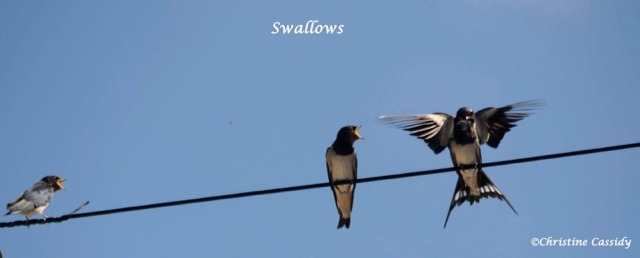 |
|
Swallow – We all know the
phrase, “one swallow doesn’t make a summer”, but already
there are enough of these glorious visitors to make us
believe summer is round the corner. They are stunning
birds, with royal blue upperparts and breast band,
cream-buff underparts and a russet forehead, chin and
throat. The tail has white markings along the inside
edges of the fork. They have long wings and long tail
streamers and are often found circling gracefully
overhead or swooping low over water and ground. They
feed on the wing by catching insects in their large
gapes. |
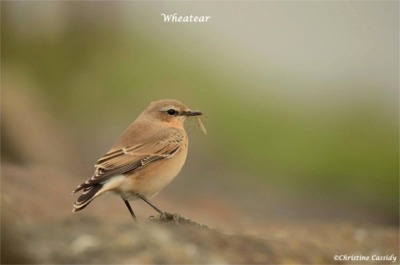 |
Wheatear – A small, mainly
ground-dwelling bird that arrives with us in Inishowen
in numbers that can often astonish. The male is
blue-grey, with black wings and white below, with an
orange flush to the breast and also sports a black eye
mask. The female lacks the blue and black colouring, but
makes up for it with wonderful tones of sandy-brown that
always remind us of their wintering in Africa and the
incredible solo journeys they make to come home again to
us in Inishowen. In flight the birds show a white rump
and a black 'T'. Once seen, loved forever. |
|
Sand Martin – These
delightful little birds have sand-brown upperparts and
the underparts are white except for a brown breast band.
The tail is forked but shorter than that of the Swallow.
The bill and legs are black-brown. Their diet comprises
of insects, such as flies and spiders that it catches in
flight. Sand Martins nest in colonies, burrowing into
banks, quarries and cliffs, and usually near water. Both
sexes construct the nest burrow and line the nest
chamber with plant material and feathers. |
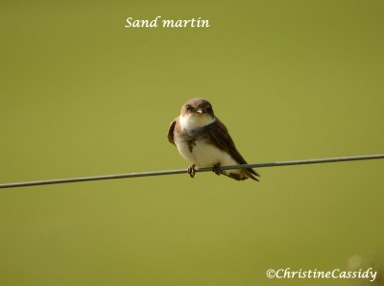 |
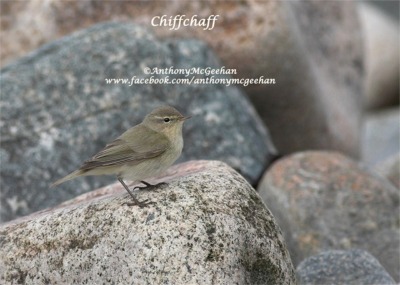 |
Chiffchaff – Most of you
will probably have already heard the distinctive call
song of this wonderful little bird, as they suddenly
seem to be everywhere! They are among the first migrant
songbirds to arrive in the spring, having wintered in
the Mediterranean and western Africa. In spring and
summer, they have brownish-green upper parts and buff
underparts. There is a dark eye stripe through the eye,
a pale eyebrow and a thin pale eye ring. They tend to be
found towards the tops of trees and bushes, in woodland
areas. The song sounds like its name - "chiff chaff". |
|
Willow Warbler – This bird
is almost indistinguishable from the Chiffchaff, other
than in song. Where the Chiffchaff proudly declares its
name repeatedly, the Willow Warbler has one of the most
beautiful songs of Spring, always cheerful and a joy to
hear. This tiny warbler has greenish-brown upper parts,
buff underparts and with a pale stripe above the eye. It
is more yellow, and sometimes has paler legs than the
Chiffchaff. Closer inspection and a keen eye reveal that
Willow Warblers also have longer wings and no eye-ring.
Willow Warblers are more often lower down in trees and
bushes and in more open, scrub areas, and can seem
nervous, constantly flicking their tail downwards. |
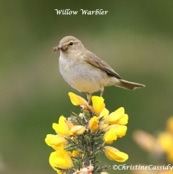 |
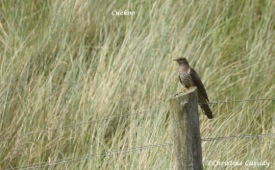 |
Cuckoo – There are few more
distinctive sounds in Spring and into Summer than the
calling of this most unusual of birds. The Cuckoo is a
brood parasite, laying its eggs in other birds' nests
and leaving the host birds to incubate and rear its
young. Dunnocks, Robins and Meadow Pipits are frequent
host birds. Each female Cuckoo specialises in using a
particular host species and will lay eggs with similar
markings to the host bird's eggs, and the young Cuckoo
will imitate the begging calls of the host's chicks. The
best places to see the Cuckoo are grassland, reed beds,
and edges of woodland. |
|
Grasshopper Warbler – This
superb warbler spends the winter in the warmer climates
of Africa and India and is a very special bird to see
and one of our rarer visitors. It is plain brownish in
colour and can be very difficult to view. It is usually
distinguished by its song, a high-pitched reeling
performed at dawn and dusk. Normally, they stay hidden
from sight, creeping through dense vegetation and laying
their eggs in nests on the ground or tussocks of grass
and undergrowth. Dramatic population declines have made
this a Red List species. |
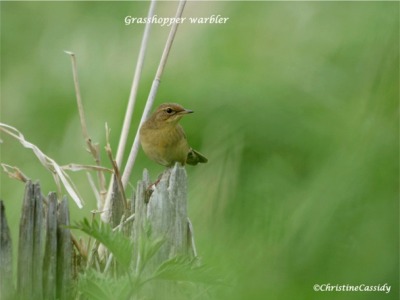 |
|
So what is the best way to
see and hear the Magnificent Seven in Inishowen? Just
get out there, watch, listen and have a great time! |
|

